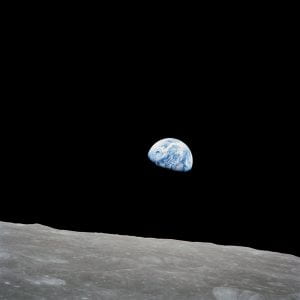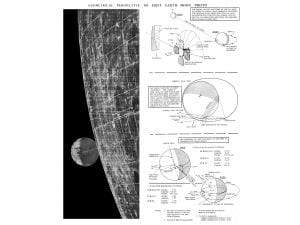Specimen of the Week 388: Lunar Orbiter Images
By ucwehlc, on 9 August 2019
In honour of the 50th anniversary of the Apollo 11 moon landing this month we have something extra-terrestrial for you.
UCL is home to an amazing collection of images taken from spacecraft; our specimen of the week is nothing less than the whole of the planet Earth as seen from the Moon

UCL’s print of Lunar Orbiter 1 Photograph 1117, the Earth viewed from lunar orbit. Copyright NASA 1966, public domain
Earthrise
Earthrise is a famous image that was taken by Apollo 8 astronaut William Anders on 24th December 1968. The picture captured the public imagination and is often cited as being one of the most important and influential photographs of all time showing the Earth looking small, fragile and alone in space.
However, this wasn’t the first image of the Earth taken from the Moon, two similar photographs were taken in August 1966 by the Lunar Orbiter Project. Five Lunar Orbiter craft were launched between 1966 and 1967, and the first three of these missions were specifically to map the surface of the Moon to plan for the first Moon landing.
To the moon and back (or not)
Our image is from Lunar Orbiter 1, which took over 200 photos covering 2 million square miles of the Moon’s surface in August 1966. These photos included two images which happened to capture the Earth in the frame.
The Lunar Orbiter used an Eastman Kodak imaging system which not only took the photographs, but developed them, scanned the images then transmitted them back to Earth. The images were then painstakingly pieced together by hand, which is why our picture has stripes where the rolls of film line up.
In order to prevent Lunar Orbiter 1 getting in the way of future lunar missions it was deliberately crashed into surface of the Moon on October 29th 1966.
Out of this world
In 1977 NASA set up a network of Regional Planetary Image Facilities (RPIFs) to hold images and maps of planets and their satellites and documents relating to space exploration. There are 16 of these facilities left and UCL hosts the only one in the UK.
Cleaned-up versions of the Lunar Orbiter 1 photographs have been made from the original analogue tapes, and all the RPIF images are now available online, but the original prints from the early days of space exploration are important objects in themselves.
We will be bringing all of the original NASA images to the main UCL campus in 2020 so they can be used in teaching, exhibitions and events, so watch this space.
Hannah Cornish is Curator of Science at UCL Culture
References
- https://solarsystem.nasa.gov/missions/lunar-orbiter-1/in-depth/
- https://www.lpi.usra.edu/library/RPIF/
- https://astrogeology.usgs.gov/Projects/LunarOrbiterDigitization/
- http://100photos.time.com/photos/nasa-earthrise-apollo-8
- https://theconversation.com/earthrise-a-photo-that-changed-the-world-109009
- https://en.wikipedia.org/wiki/Lunar_Orbiter_Image_Recovery_Project
- https://en.wikipedia.org/wiki/Lunar_Orbiter_program
 Close
Close



